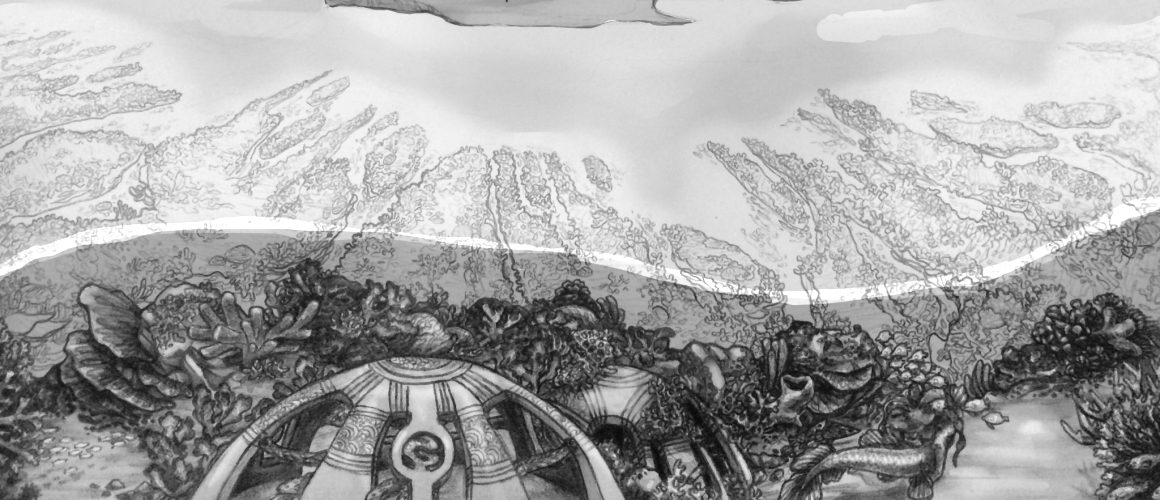The Coral Graveyard
The barrier reefs off the South coast of Maloeku hold an important cultural purpose to Maloekians. Buried deep within the reefs are countless skeletons of the deceased. Just like their goddess, Mellikala, Maloekians give their bodies to the sea, to grow and nourish it for future generations. Their skeletons and the stone constructs they reside in act as an artificial reef that helps to maintain and grow the barrier reef. It can take anywhere from 5 to 20 years for a stone construct to be completely lost beneath the coral.
Triangle
Reserved for children.
Rectangle
Commoners with no special recognitions.
Pentagon
Military or those with special recognition.
6-8 Sided Polygon
Members of the government or those who have done a great service to the country. Number of sides increases according to standing and contribution.
Dome
Reserved for royalty.
Motifs
A variety of motifs are carved into the stone constructs detailing things such as waves, clouds, flowers, and ocean life.
Clay Sculptures
Clay mixed with the cremated remains of the deceased is sculpted into symbolic animals and placed in, and on the stone construct.
Ropes
Ropes made from the hair of the deceased are wound around the construct and tied off with a loop of metal.
Visitation
Although there is not usually a problem as memorial services are not part of Maloekian culture, no visitation is allowed after the family and friends of the deceased take part in the initial placing and decorating the stone construct. However, in certain cases, shortly after a stone construct is established, a family may return to add something to the construct that was originally forgotten. This rule is put in place to prevent the disturbance of the corals growing on the construct and others around it.
State of the Body
As of 1027 S.D., the body of the deceased must not have any flesh left on it, only the skeleton may be placed within the stone constructs. This is to reduce the possibility of another corpse kelp outbreak after the Graveyard Crisis.
Securing the Body
Ancient records tell of countless bodies washing up on shore after a heavy storm as the reason behind tying the bodies to the coral with ropes made of the deceased's hair. Although the stone constructs make such an event less likely to happen, it still required that the bodies be well secured so as to prevent such an occurrence.
History
In the past, the bodies of the deceased were tied closely to the existing reefs with a rope made of their hair. Across the reefs, bodies could be seen at various stages of decomposition, feeding the fish that lived in the reefs until all that was left was a skeleton which the corals would begin to grow on. Later, the process became more ritualistic, with stone constructs containing the body and various personal effects. Eventually, due to the Graveyard Crisis, the body would be prepared so that only the skeleton was placed in the reef. The flesh of the deceased would be cremated and mixed into clay decorations on the stone constructs.Stone Constructs
Form
The stone constructs are hollow structures made of carved stone. The outer shell is filled with holes which allow fish to swim through them and corals to grow throughout. The shape of the construct varies depending on the deceased.Decoration
A variety of decorations personalize the graves though they are eventually lost amongst the coral growth. The amount of decoration usually depends on the wealth of the deceased's family.Upkeep
The Coral Graveyards are maintained by the Deljudi tribesmen who settled in Maloekian waters mid 15th century S.D and some Maloekian islanders. They guard the stone constructs, ensuring that they are not desecrated, and prevent the Corpse Kelps from intruding into the reef.Regulations
Geography
The Coral Graveyard is a large barrier reef off the south of Maloeku that stretches for over 800 km and has an area of approximately 160,000 km2. Separated from the island by a large lagoon it is home to a wide array of corals and sea life. Surrounding the outside of the reef is a barrier forest of Corpse Kelp which protects the reef ecosystem and the island of Maloeku off from large sea creatures.
Her hair became the sea, Her body the reefs, and each teardrop a new life.
Type
Coral Reef, Barrier
Remove these ads. Join the Worldbuilders Guild









Comments